INSTALL NO. 1 VACUUM SWITCHING VALVE ASSEMBLY (w/ Intercooler)
INSTALL FUEL FILTER TO INJECTION PUMP FUEL PIPE SUB-ASSEMBLY
INSTALL TUBE CONNECTOR TO FLEXIBLE HOSE TUBE (for Manual Transaxle)
INSTALL VISCOUS HEATER ASSEMBLY WITH MAGNET CLUTCH (w/ Viscous Heater)
Camshaft (W/O Dpf) -- Installation |
- CAUTION:
- When replacing an injector (including interchanging injectors between cylinders), common rail, cylinder head, or intake manifold, replace the corresponding injection pipes with a new one.
| 1. CHECK INJECTOR COMPENSATION CODE |
 |
- NOTICE:
- When a fuel injector is replaced, the new fuel injector compensation code must be input into the ECM. When the ECM is replaced, all of the existing fuel injector compensation codes must be input into the new ECM.
- Fuel injector compensation codes are unique, 30 digit, alphanumeric values printed on the head portion of each fuel injector. If an incorrect fuel injector compensation code is input into the ECM, the engine assembly may rattle or engine idling may become rough. In addition, engine failure may occur and the life of the engine may be shortened.
After replacing fuel injector(s) with new one(s), input compensation code(s) of fuel injector(s) into ECM as follows:
- HINT:
- Each fuel injector has different fuel injection characteristics. In order to optimize the fuel injections, the ECM uses the compensation codes to balance the different fuel injections between each fuel injector.
- When you first turn the ignition switch to ON after replacing the ECM or a fuel injector(s), DTC P1601 is set. This is to inform you that registration of a fuel injector compensation code(s) is/are required. Manually clear the DTC upon completion of the compensation code registration.
Input the compensation code(s), which is/are imprinted on the head portion(s) of the new fuel injector(s), into the intelligent tester.
Input the new compensation code(s) into the ECM using the tester.
Turn the tester off and turn the ignition switch off.
Wait for at least 30 seconds.
Turn the ignition switch to ON and turn the tester on.
Clear DTC P1601 stored in the ECM using the tester (Click here).
Register compensation code.
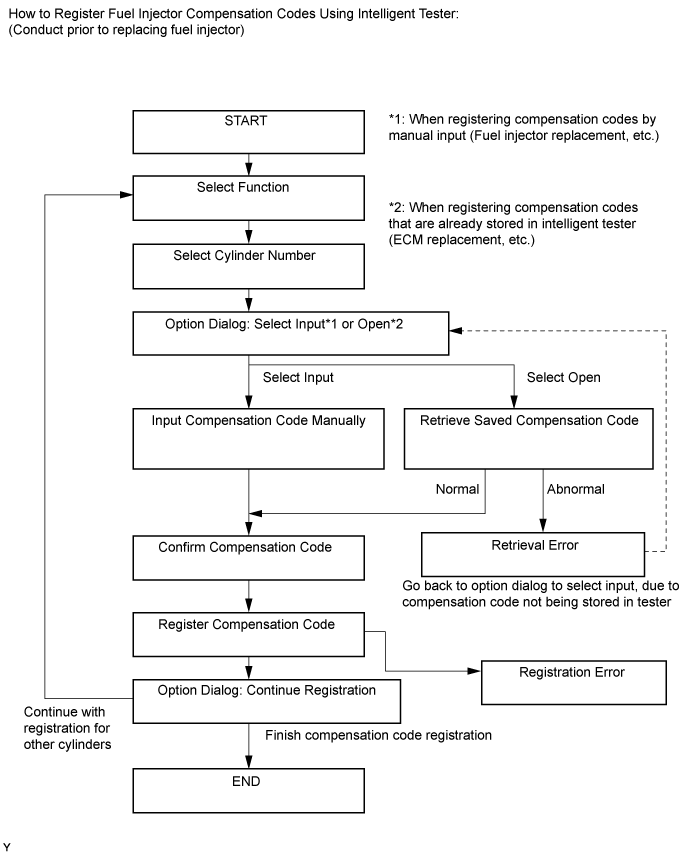
Connect the intelligent tester to the DLC3.
Turn the ignition switch to ON.
- NOTICE:
- Do not start the engine.
Turn the tester on.
Enter the following menus: Powertrain / Engine / Utility / Injector Compensation.
Press Next.
Press Next again to proceed.
Select "Set Compensation Code".
Press Next.
Select the number of the cylinder corresponding to the fuel injector compensation code that you want to read.
Press Next.
Register compensation code.
- Press Input.
Manually input the cylinder compensation code using the keyboard on the tester screen. The code is a 30 digit, alphanumeric value printed on the injector head portion.
- HINT:
- Each fuel injector compensation code is unique. The compensation code for each selected cylinder must be input into the tester correctly.
- Confirm that the compensation code for the selected cylinder is correct, and then press OK.
- Press Input.
Check that the compensation code displayed on the screen is correct by comparing it with the 30 digit alphanumeric value on the head portion of the fuel injector.
- NOTICE:
- If an incorrect fuel injector compensation code is input into the ECM, the engine may rattle or engine idling may become rough. In addition, engine failure may occur and the life of the engine may be shortened.
- HINT:
- If a wrong compensation code is input or read, return to the Input Value screen by pressing Input.
- The saving process may fail due to a problem with the wire harness or a bad connection with the DLC3. Check the wire harness and DLC3 connection. If no problem is found with either, the ECM may be malfunctioning. Check the ECM and repeat this operation.
Press Next to register the compensation code in the ECM.
- HINT:
- If the registration process fails, the compensation code may be incorrect. Check the compensation code again.
- If the input compensation code fails to register even though it is input correctly, there may be a problem with the wire harness or a bad connection with the DLC3. Check the wire harness and DLC3 connection. If no problem is found with either, the ECM may be malfunctioning. Check the ECM and restart this operation.
If you want to continue with other compensation code registrations, press Next. To finish the registration, press Cancel.
Turn the ignition switch off and then turn the tester off.
Wait for at least 30 seconds.
Turn the ignition switch to ON and then turn the tester on.
Clear DTC P1601 stored in the ECM using the tester (Click here).







| 2. INSTALL NO. 3 AND NO. 4 CAMSHAFTS |
- NOTICE:
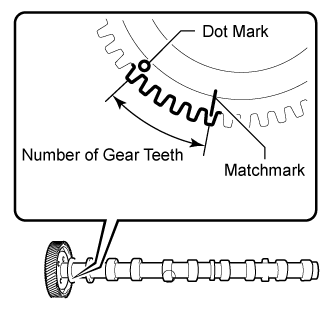 |
- If replacing a camshaft with a new one, make a matchmark on the new camshaft in the same place as the old camshaft. Determine the matchmark placement by using the dot mark as a reference point and counting the number of gear teeth from the dot mark to the matchmark as shown in the illustration.
w/o Intercooler:
When replacing the No. 4 camshaft with a new one, install a new hole plug (Click here).
Add more than 19 cc (1.16 cu. in.) of engine oil into the cylinder head side oil holes.
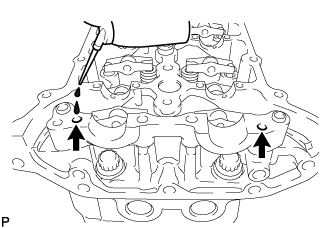 |
Apply engine oil to the rollers of the valve rocker arms and the camshaft housing of the cylinder head.
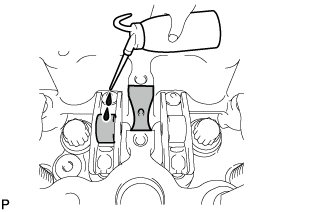 |
Install the No. 3 and No. 4 camshafts.
Apply engine oil to the camshaft journals, lobes, thrust portion and gears.
Align the matchmarks of the No. 3 and No. 4 camshaft timing gears as shown in the illustration.
 |
Place the camshafts into the cylinder head.
- NOTICE:
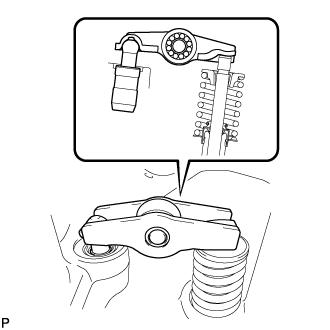
- Before and after setting the camshafts, firmly set the rocker arms to the lash adjusters.
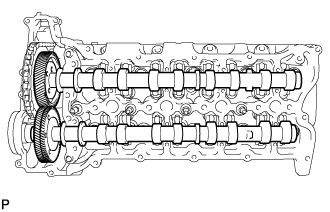 |
Install the No. 4 camshaft bearing cap.
Align the No. 4 camshaft bearing cap and the ring pins of the No. 5 camshaft bearing cap.
Temporarily install the 4 bolts by hand.
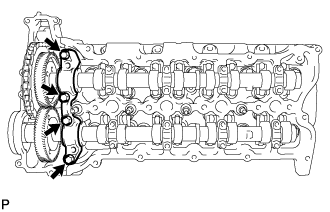 |
Install the No. 3 camshaft bearing caps.
Confirm the marks and numbers on the camshaft bearing caps and place them in their proper position and direction.
Temporarily install the 8 bolts, which are not installed with the oil feed pipe, by hand.
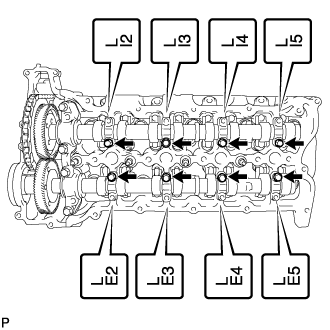 |
Temporarily install the No. 3 and No. 4 camshaft oil feed pipes with the 8 bolts by hand.
- NOTICE:
- If even one of the pipe bolt holes does not match its camshaft bearing cap bolt hole, replace the camshaft oil feed pipe.
- HINT:
- The pipe is bent on the intake side, and straight on the exhaust side.
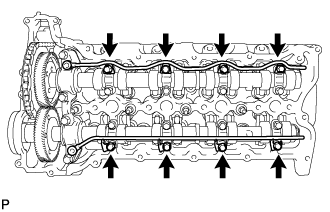 |
Temporarily install the 2 union bolts by hand.
 |
Uniformly tighten the 20 bolts in several steps in the order shown in the illustration.
- Torque:
- for 12 mm head bolt of No. 4 camshaft bearing cap:
- 21 N*m{214 kgf*cm, 15 ft.*lbf}
- for 10 mm head bolt of No. 3 camshaft bearing cap:
- 10 N*m{102 kgf*cm, 7 ft.*lbf}
 |
Tighten the 2 union bolts.
- Torque:
- 17 N*m{173 kgf*cm, 13 ft.*lbf}
 |
Remove the service bolt from the No. 4 camshaft timing gear.
- NOTICE:
- Do not drop the bolt into the engine.
- HINT:
- If the bolt is difficult to remove, rotate the camshaft and remove the bolt. Then realign the matchmarks of the No. 3 and No. 4 camshaft timing gears.
 |
Temporarily install the No. 2 timing chain and No. 2 camshaft timing sprocket to the No. 3 camshaft with the 2 bolts.
 |
Using SST, hold the No. 2 camshaft timing sprocket. Tighten the 2 bolts.
- SST
- 09960-10010(09962-01000,09963-01000)
- Torque:
- 25 N*m{250 kgf*cm, 18 ft.*lbf}
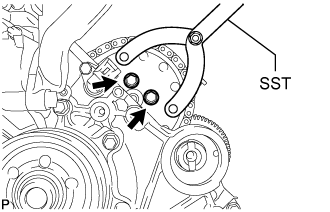 |
Rotate the crankshaft pulley clockwise so that the 2 remaining pump drive shaft gear bolts can be installed.
Temporarily install the 2 bolts to the No. 3 camshaft.
 |
Using SST, hold the No. 2 camshaft timing sprocket. Tighten the 2 bolts.
- SST
- 09960-10010(09962-01000,09963-01000)
- Torque:
- 25 N*m{250 kgf*cm, 18 ft.*lbf}
 |
Remove the hexagon wrench from the No. 2 chain tensioner.
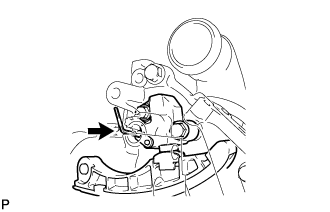 |
Remove the adhesive from the threads of the taper screw plug and the bolt hole of the timing gear case.
Apply adhesive to 3 or more threads of the taper screw plug.
- Adhesive:
- Toyota Genuine Adhesive 1344, Three Bond 1344 or equivalent
 |
Using a 10 mm hexagon wrench, install the taper screw plug.
- Torque:
- 15 N*m{153 kgf*cm, 11 ft.*lbf}
 |
| 3. INSTALL NO. 1 AND NO. 2 CAMSHAFTS |
 |
- NOTICE:
- If replacing a camshaft with a new one, make a matchmark on the new camshaft in the same place as the old camshaft. Determine the matchmark placement by using the dot mark as a reference point and counting the number of gear teeth from the dot mark to the matchmark as shown in the illustration.
Add more than 19 cc (1.16 cu. in.) of engine oil into the cylinder head side oil holes.
 |
Apply engine oil to the rollers of the valve rocker arms and the camshaft housing of the cylinder head.
 |
Install the No. 1 and No. 2 camshafts.
Apply engine oil to the camshaft journals, lobes, thrust portion and gears.
Align the matchmarks of the No. 1 and No. 2 camshaft timing gears as shown in the illustration.
Place the 2 camshafts into the cylinder head.
- NOTICE:

- Before and after setting the camshafts, firmly set the rocker arms to the lash adjusters.


Install the No. 1 camshaft bearing cap.
Align the No. 1 camshaft bearing cap and the ring pins of the No. 2 camshaft bearing cap.
Temporarily install the 4 bolts by hand.
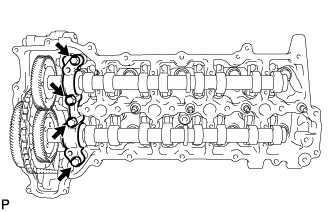 |
Install the No. 3 camshaft bearing caps.
Confirm the marks and numbers on the camshaft bearing caps and place them in their proper position and direction.
Temporarily install the 8 bolts, which are not installed with the oil feed pipe, by hand.
 |
Temporarily install the No. 1 and No. 2 camshaft oil feed pipes with the 8 bolts by hand.
- NOTICE:
- If even one of the pipe bolt holes does not match its camshaft bearing cap bolt hole, replace the camshaft oil feed pipe.
- HINT:
- The pipe is bent on the intake side, and straight on the exhaust side.
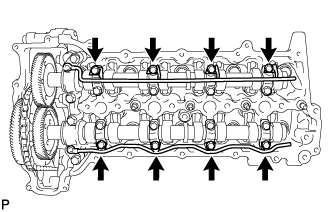 |
Temporarily install the 2 union bolts by hand.
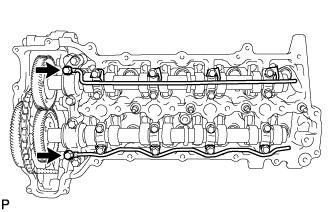 |
Uniformly tighten the 20 bolts in several steps in the order shown in the illustration.
- Torque:
- for 12 mm head bolt of No. 1 camshaft bearing cap:
- 21 N*m{214 kgf*cm, 15 ft.*lbf}
- for 10 mm head bolt of No. 3 camshaft bearing cap:
- 10 N*m{102 kgf*cm, 7 ft.*lbf}
 |
Tighten the 2 union bolts.
- Torque:
- 17 N*m{173 kgf*cm, 13 ft.*lbf}
 |
Remove the service bolt from the No. 1 camshaft timing gear.
- NOTICE:
- Do not drop the bolt into the engine.
- HINT:
- If the bolt is difficult to remove, rotate the camshaft and remove the bolt. Then realign the matchmarks of the No. 1 and No. 2 camshaft timing gears.
 |
Temporarily install the No. 1 timing chain and No. 1 camshaft timing sprocket to the No. 2 camshaft.
Temporarily install the pump drive shaft gear with the 2 bolts.
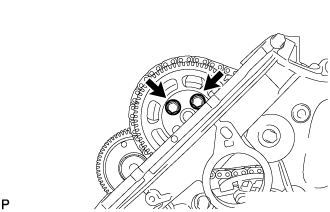 |
Using SST, hold the pump drive shaft gear. Tighten the 2 bolts.
- SST
- 09960-10010(09962-01000,09963-01000)
- Torque:
- 25 N*m{250 kgf*cm, 18 ft.*lbf}
 |
Rotate the crankshaft clockwise so that the 2 remaining pump drive shaft gear bolts can be installed.
Temporarily install the 2 bolts to the pump drive shaft gear.
 |
Using SST, hold the pump drive shaft gear. Tighten the 2 bolts.
- SST
- 09960-10010(09962-01000,09963-01000)
- Torque:
- 25 N*m{250 kgf*cm, 18 ft.*lbf}
 |
Remove the hexagon wrench.
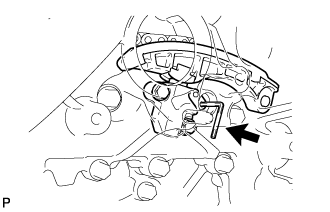 |
Remove the adhesive from the threads of the taper screw plug and the bolt hole of the timing gear case.
Apply adhesive to 3 or more threads of the taper screw plug.
- Adhesive:
- Toyota Genuine Adhesive 1344, Three Bond 1344 or equivalent
 |
Using a 10 mm hexagon wrench, install the taper screw plug.
- Torque:
- 15 N*m{153 kgf*cm, 11 ft.*lbf}
 |
| 4. CHECK NO. 1 CYLINDER TO TDC/COMPRESSION |
Rotate the crankshaft clockwise 3 times or more, and check that the timing marks of the camshafts (1 dot mark each) align. If the timing marks of the camshafts do not align, repeat the "Install No. 3 and No. 4 Camshafts" and "Install No. 1 and No. 2 Camshafts" procedures.

| 5. INSTALL FUEL INJECTOR LH |
- NOTICE:
- Be sure to install the injector, holder clamp and bolt to their original positions.
Install 4 new injection nozzle seats to the cylinder head.
 |
Apply a light coat of clean engine oil to 4 new O-rings.
Text in Illustration *1 New O-Ring
 |
Install the O-rings to each injector as shown in the illustration.
Insert the 4 injectors into the cylinder head.
- NOTICE:
- Insert the injector until it touches the nozzle seat surface.
- After installing the injector to the cylinder head, the O-ring may prevent the injector from fully seating. If so, pull out the injector and reinstall it.
- Always return an injector to the same place it was removed from.
For an injector that has been replaced with a new injector, register the injector compensation code.
Temporarily install 4 new washers and the 4 nozzle clamps with the 4 clamp bolts.
- NOTICE:
The fork portion of the nozzle holder clamp must be set on the injector.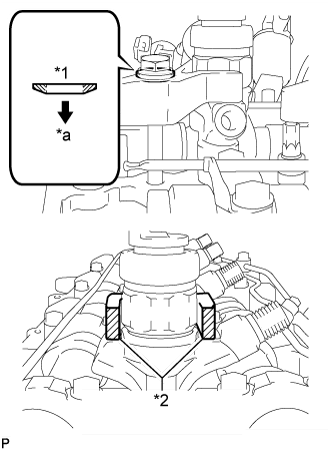
- Before tightening the bolts, check that the nozzle holder clamp is set properly.
- To tighten the clamp bolts, first tighten them by hand until they cannot be turned further. Then, tighten the bolts to the specified torque in a later step.
- When tightening the bolts, be careful not to tilt the bolt and clamp.
- Do not reuse the washer.
Text in Illustration *1 Washer *2 Nozzle Holder Clamp *a Downward
Temporarily install the common rail LH with the 2 bolts.
 |
Temporarily install 4 new injection pipes to the common rail and injector.
 |
Check the nozzle leakage pipe. Check that there are no scratches or dents on the 5 union seal surfaces. If scratches or dents are present, replace the nozzle leakage pipe.
Text in Illustration *1 Nozzle Leakage Pipe
 |
Set the leakage pipe and 5 new gaskets in place.
Temporarily install the leakage pipe with the 4 hollow screws and union bolt.
Text in Illustration 
Union Bolt - HINT:
- To position the injectors, loosely tighten the 4 hollow screws and union bolt.
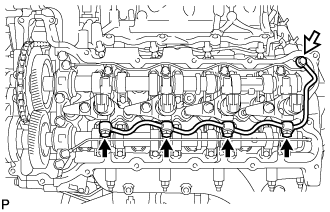 |
Tighten the 4 holder clamp bolts.
- Torque:
- 25 N*m{255 kgf*cm, 18 ft.*lbf}
Remove the 4 injection pipes.
Remove the 2 bolts and common rail LH.
Tighten the 4 hollow screws.
- Torque:
- 18 N*m{184 kgf*cm, 13 ft.*lbf}
- NOTICE:
- If a hollow screw is accidentally tightened beyond the torque specification, it must be replaced together with the nozzle leakage pipe.
 |
Tighten the union bolt.
- Torque:
- 21 N*m{214 kgf*cm, 15 ft.*lbf}
- NOTICE:
- If the union bolt is accidentally tightened beyond the torque specification, it must be replaced together with the nozzle leakage pipe.
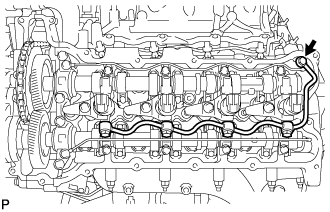 |
| 6. INSTALL FUEL INJECTOR RH |
- NOTICE:
- Be sure to install the injector, holder clamp and bolt to their original positions.
Install 4 new injection nozzle seats to the cylinder head.
 |
Apply a light coat of clean engine oil to 4 new O-rings.
Text in Illustration *1 New O-Ring
 |
Install the O-rings to each injector as shown in the illustration.
Insert the 4 injectors into the cylinder head.
- NOTICE:
- Insert the injector until it touches the nozzle seat surface.
- After installing the injector to the cylinder head, the O-ring may prevent the injector from fully seating. If so, pull out the injector and reinstall it.
- Always return an injector to the same place it was removed from.
For an injector that has been replaced with a new injector, register the injector compensation code.
Temporarily install 4 new washers and the 4 nozzle clamps with the 4 clamp bolts.
- NOTICE:
The fork portion of the nozzle holder clamp must be set on the injector.
- Before tightening the bolts, check that the nozzle holder clamp is set properly.
- To tighten the clamp bolts, first tighten them by hand until they cannot be turned further. Then, tighten the bolts to the specified torque in a later step.
- When tightening the bolts, be careful not to tilt the bolt and clamp.
- Do not reuse the washer.
Text in Illustration *1 Washer *2 Nozzle Holder Clamp *a Downward
Temporarily install 4 new injection pipes to the common rail and injector.
 |
Check the nozzle leakage pipe. Check that there are no scratches or dents on the 5 union seal surfaces. If scratches or dents are present, replace the nozzle leakage pipe.
Text in Illustration *1 Nozzle Leakage Pipe
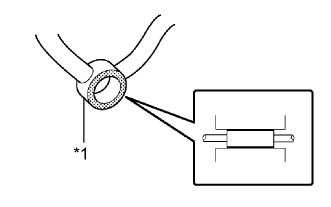 |
Set the leakage pipe and 5 new gaskets in place.
Temporarily install the leakage pipe with the 4 hollow screws and union bolt.
Text in Illustration 
Union Bolt - HINT:
- To position the injectors, loosely tighten the 4 hollow screws and union bolt.
 |
Tighten the 4 holder clamp bolts.
- Torque:
- 25 N*m{255 kgf*cm, 18 ft.*lbf}
Remove the 4 injection pipes.
Tighten the 4 hollow screws.
- Torque:
- 18 N*m{184 kgf*cm, 13 ft.*lbf}
- NOTICE:
- If a hollow screw is accidentally tightened beyond the torque specification, it must be replaced together with the nozzle leakage pipe.
 |
Tighten the union bolt.
- Torque:
- 21 N*m{214 kgf*cm, 15 ft.*lbf}
- NOTICE:
- If the union bolt is accidentally tightened beyond the torque specification, it must be replaced together with the nozzle leakage pipe.
 |
| 7. INSTALL NOZZLE HOLDER GASKET LH |
Press 4 new nozzle holder gaskets into the cylinder head cover LH.
- NOTICE:
- After installing the nozzle holder gasket, check that it does not protrude from the cylinder head cover.
Text in Illustration *1 Nozzle Holder Gasket
 |
| 8. INSTALL CYLINDER HEAD COVER SUB-ASSEMBLY LH |
Apply seal packing as shown in the illustration.
- Seal packing:
- Toyota Genuine Seal Packing Black, Three Bond 1207B or equivalent
Text in Illustration 
Seal Packing - NOTICE:
- Remove any oil from the contact surface.
- Install the cylinder head cover within 3 minutes and tighten the bolts within 15 minutes after applying seal packing.
- Do not start the engine for at least 2 hours after the installation.
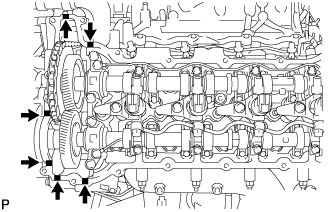 |
Install a new gasket to the cylinder head cover.
- NOTICE:
- Remove any oil from the contact surface.
Temporarily install the cylinder head cover with the 17 bolts. Tighten the 17 bolts in the order shown in the illustration.
- Torque:
- 10 N*m{102 kgf*cm, 7 ft.*lbf}
- HINT:
- After tightening the bolts, check that the bolts at step 11 and 19 are tightened to the specified torque.
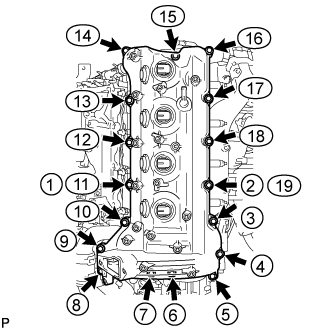 |
| 9. INSTALL NOZZLE HOLDER SEAL LH |
Press 4 new holder seals into the cylinder head cover LH.
| 10. INSTALL OIL SEPARATOR ASSEMBLY |
Install a new gasket to the oil separator.
- NOTICE:
- Remove any oil from the contact surface.
Install the oil separator with the 3 bolts.
- Torque:
- 10 N*m{102 kgf*cm, 7 ft.*lbf}
| 11. INSTALL NOZZLE HOLDER GASKET RH |
Press 4 new nozzle holder gaskets into the cylinder head cover RH.
- NOTICE:
- After installing the nozzle holder gasket, check that it does not protrude from the cylinder head cover.
Text in Illustration *1 Nozzle Holder Gasket
 |
| 12. INSTALL CYLINDER HEAD COVER SUB-ASSEMBLY RH |
Apply seal packing as shown in the illustration.
- Seal packing:
- Toyota Genuine Seal Packing Black, Three Bond 1207B or equivalent
Text in Illustration 
Seal Packing - NOTICE:
- Remove any oil from the contact surface.
- Install the cylinder head cover within 3 minutes and tighten the bolts within 15 minutes after applying seal packing.
- Do not start the engine for at least 2 hours after the installation.
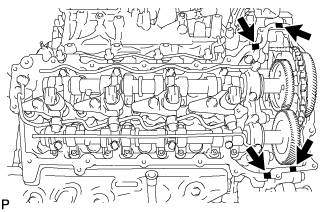 |
Install a new gasket to the cylinder head cover.
- NOTICE:
- Remove any oil from the contact surface.
Temporarily install the cylinder head cover with the 18 bolts. Tighten the 18 bolts in the order shown in the illustration.
- Torque:
- 10 N*m{102 kgf*cm, 7 ft.*lbf}
- HINT:
- After tightening the bolts, check that the bolts at step 11 and 20 are tightened to the specified torque.
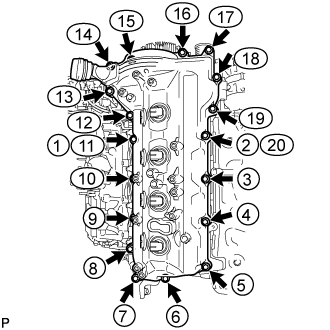 |
| 13. INSTALL NOZZLE HOLDER SEAL RH |
Press 4 new holder seals into the cylinder head cover LH.
| 14. INSTALL CYLINDER HEAD COVER SILENCER LH (w/ Intercooler) |
Install the cylinder head cover silencer with the 3 bolts.
- Torque:
- 5.0 N*m{51 kgf*cm, 44 in.*lbf}
| 15. INSTALL CYLINDER HEAD COVER SILENCER RH (w/ Intercooler) |
Install the cylinder head cover silencer with the 3 bolts.
- Torque:
- 5.0 N*m{51 kgf*cm, 44 in.*lbf}
| 16. CONNECT NO. 3 VENTILATION HOSE |
| 17. CONNECT NO. 2 VENTILATION HOSE |
| 18. INSTALL VACUUM PUMP ASSEMBLY (w/ Intercooler) |
Apply engine oil to 2 new O-rings.
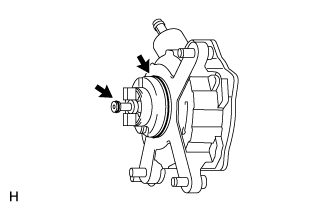 |
Install the 2 O-rings to the vacuum pump.
Install the vacuum pump so that the coupling teeth of the vacuum pump (labeled A) and the groove of the camshaft (labeled B) are aligned.
- NOTICE:
- Be careful not to damage the O-ring.
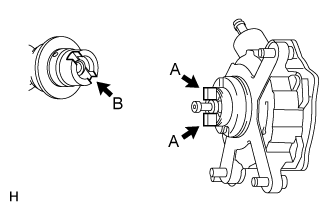 |
Install the vacuum pump with the 3 bolts.
- Torque:
- 21 N*m{214 kgf*cm, 15 ft.*lbf}
- NOTICE:
- Confirm that the vacuum pump is not at an angle, and that there is no clearance between the fitting surfaces.
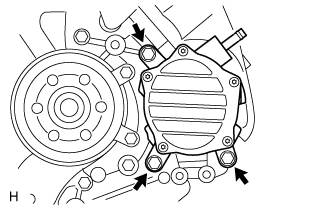 |
| 19. INSTALL NO. 1 VACUUM TRANSMITTING PIPE SUB-ASSEMBLY |
Install the vacuum transmitting pipe with the 3 bolts.
- Torque:
- 6.0 N*m{61 kgf*cm, 53 in.*lbf}
w/ Intercooler:
Connect the 2 vacuum hoses.
| 20. INSTALL NO. 1 VACUUM SWITCHING VALVE ASSEMBLY (w/ Intercooler) |
Install the vacuum switching valve with the bolt.
- Torque:
- 6.0 N*m{61 kgf*cm, 53 in.*lbf}
Connect the 2 vacuum hoses.
| 21. INSTALL NO. 2 IDLER PULLEY BRACKET (w/ Viscous Heater) |
Temporarily install the No. 2 idler pulley bracket with the bolt.
 |
Temporarily install the 2 bolts to the No. 2 idler pulley bracket bolt hole.
Uniformly tighten the 3 bolts of the No. 2 idler pulley bracket in the order shown in the illustration.
- Torque:
- 49 N*m{495 kgf*cm, 36 ft.*lbf}
 |
| 22. INSTALL NO. 2 IDLER PULLEY (w/ Viscous Heater) |
Install the collar, No. 2 idler pulley and cover with the bolt.
- Torque:
- 49 N*m{495 kgf*cm, 36 ft.*lbf}
 |
| 23. INSTALL INJECTION PIPE RH |
Using a union nut wrench, install 4 new injection pipes.
- Torque:
- 34 N*m{347 kgf*cm, 25 ft.*lbf}
- NOTICE:
- Make sure there is no damage or foreign matter on the seal surfaces.
- Use the formula to calculate special torque values for situations where a union nut wrench is combined with a torque wrench (Click here).
w/ Intercooler:
Install the 4 injection pipe clamps with the 2 nuts.- Torque:
- 5.0 N*m{51 kgf*cm, 44 in.*lbf}
| 24. CONNECT NO. 2 ENGINE WIRE |
Connect the No. 2 engine wire with the 3 bolts.
- Torque:
- for bolt A:
- 13 N*m{133 kgf*cm, 10 ft.*lbf}
- for bolt B:
- 32 N*m{326 kgf*cm, 24 ft.*lbf}
 |
Attach the 2 wire harness clamps.
| 25. INSTALL FUEL FILTER TO INJECTION PUMP FUEL PIPE SUB-ASSEMBLY |
w/ DPF:
- NOTICE:
- Check for damage and foreign matter on the fuel pipe installation surface of the fuel supply pump.
- If there is foreign matter, remove it from the installation surface.
- If the installation surface is damaged, replace the fuel supply pump.
Temporarily install a new gasket and fuel filter to injection pump fuel pipe with the nut, bolt and union bolt.
Install the No. 2 injection pipe clamp with the bolt.
- Torque:
- 4.0 N*m{41 kgf*cm, 35 in.*lbf}
Tighten the union bolt, bolt and nut.
- Torque:
- for union bolt:
- 12 N*m{125 kgf*cm, 9 ft.*lbf}
- for bolt and nut:
- 10 N*m{102 kgf*cm, 7 ft.*lbf}
Connect the fuel hose.
w/o DPF:
Install the fuel filter to injection pump fuel pipe with the bolt.
- Torque:
- 10 N*m{102 kgf*cm, 7 ft.*lbf}
Connect the 2 hoses to the fuel pipe.
| 26. INSTALL COMMON RAIL ASSEMBLY LH |
Install the common rail with the 2 bolts.
- Torque:
- 21 N*m{214 kgf*cm, 15 ft.*lbf}
| 27. INSTALL INJECTION PIPE LH |
Using a union nut wrench, install the 4 new injection pipes.
- Torque:
- 34 N*m{347 kgf*cm, 25 ft.*lbf}
- NOTICE:
- Make sure there is no damage or foreign matter on the seal surfaces.
- Use the formula to calculate special torque values for situations where a union nut wrench is combined with a torque wrench (Click here).
w/ Intercooler:
Install the 4 injection pipe clamps with the 2 nuts.- Torque:
- 5.0 N*m{51 kgf*cm, 44 in.*lbf}
| 28. INSTALL NO. 6 INJECTION PIPE SUB-ASSEMBLY |
w/ EGR System:
Temporarily install a new No. 6 injection pipe to the common rail LH and RH.
- NOTICE:
- Make sure there is no damage or foreign matter on the seal surfaces.
Install the 2 No. 2 injection pipe clamps with the 2 nuts.
- Torque:
- 5.0 N*m{51 kgf*cm, 44 in.*lbf}
Using a union nut wrench, tighten the No. 6 injection pipe ends.
- Torque:
- 34 N*m{347 kgf*cm, 25 ft.*lbf}
- NOTICE:
- Use the formula to calculate special torque values for situations where a union nut wrench is combined with a torque wrench (Click here).
w/o EGR System:
Temporarily install a new No. 6 injection pipe to the common rail LH and RH.
- NOTICE:
- Make sure there is no damage or foreign matter on the seal surfaces.
Install the bracket to the No. 3 intake manifold with the bolt.
- Torque:
- 10 N*m{102 kgf*cm, 7 ft.*lbf}
Install the No. 2 injection pipe clamp with the nut.
- Torque:
- 5.0 N*m{51 kgf*cm, 44 in.*lbf}
Using a union nut wrench, tighten the No. 6 injection pipe ends.
- Torque:
- 34 N*m{347 kgf*cm, 25 ft.*lbf}
- NOTICE:
- Use the formula to calculate special torque values for situations where a union nut wrench is combined with a torque wrench (Click here).
| 29. INSTALL NO. 2 FUEL PIPE SUB-ASSEMBLY |
- NOTICE:
- Check for damage and foreign matter on the fuel pipe installation surface of the supply pump.
- If there is foreign matter, remove it from the installation surface. If the installation surface is damaged, replace the fuel supply pump.
Temporarily install a new gasket and the No. 2 fuel pipe with the union bolt, nut and bolt.
 |
Tighten the union bolt, nut and bolt in the order shown in the illustration.
- Torque:
- for union bolt:
- 25 N*m{255 kgf*cm, 18 ft.*lbf}
- for bolt and nut:
- 10 N*m{102 kgf*cm, 7 ft.*lbf}
Install the No. 2 injection pipe clamp with the bolt.
- Torque:
- 4.0 N*m{41 kgf*cm, 35 in.*lbf}
Connect the fuel hose to the No. 5 nozzle leakage pipe.
| 30. CONNECT ENGINE WIRE |
RH side:
Install the engine wire harness protector with the 3 bolts labeled A.
Connect the 7 connectors.
Attach the wire harness clamp.
Install the wire harness bracket with the bolt labeled B.
Install the glow plug wire harness with the nut labeled C.
- Torque:
- 4.0 N*m{41 kgf*cm, 35 in.*lbf}
Attach the 5 wire harness clamps and connect the 4 connectors.


LH side:
Install the engine wire harness protector with the 2 bolts labeled A.
Connect the 8 connectors.
Install the wire harness bracket with the bolt labeled B.
for RHD:
Connect the wire harness with the wire harness clamp holder labeled C.Attach the 3 wire harness clamps and connect the 2 connectors.
Attach the 3 wire harness clamps and connect the 4 connectors.
Connect the wire harness with the wire harness clamp holder labeled B.
Attach the ground wire clamp labeled A to the relay block side.
Install the ground wire to the body panel with the bolt.
- Torque:
- 8.4 N*m{87 kgf*cm, 74 in.*lbf}
Connect the 4 connectors to the injector driver.
Install the ground wire with the bolt.
- Torque:
- 8.4 N*m{86 kgf*cm, 74 in.*lbf}
Connect the wire harness holder to the relay block.
Connect the 4 connectors to the relay block.
Connect the wire harness with the wire harness clamp holder.


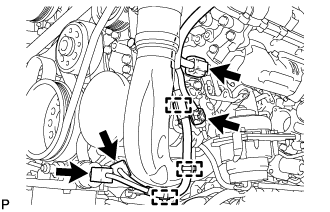
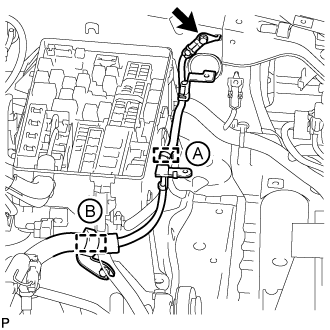

for RHD:
Connect the wire harness with the wire harness clamp holder.
Connect the ECM connector to the ECM.
Connect the wire harness with the wire harness clamp holder.
Attach the wire harness tab labeled A to the relay block.
Connect the 4 connectors to the relay block.
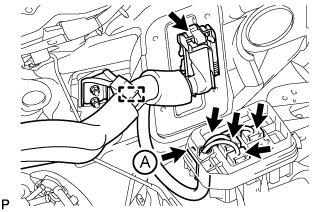
 |
for LHD:
Connect the wire harness with the wire harness clamp holder.
Connect the ECM connector to the ECM.
Attach the wire harness tab labeled A to the relay block.
Connect the 4 connectors to the relay block.
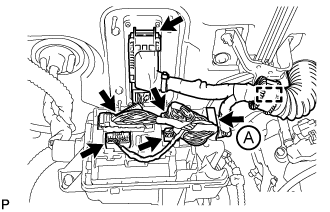 |
| 31. CONNECT FUEL HOSE |
| 32. INSTALL NO. 4 WATER BY-PASS PIPE |
w/ EGR System:
w/ DPF:
Connect the 3 water hose ends, and temporarily install the No. 4 water by-pass pipe with the 2 bolts and nut.w/o DPF:
Connect the 4 water hose ends, and temporarily install the No. 4 water by-pass pipe with the 2 bolts and nut.
w/o EGR System:
Connect the 3 water hose ends, and temporarily install the No. 4 water by-pass pipe with the 2 bolts and nut.
First tighten the 2 bolts and then tighten the nut.
- Torque:
- 10 N*m{102 kgf*cm, 7 ft.*lbf}
| 33. INSTALL NO. 3 WATER BY-PASS PIPE (w/o Viscous Heater) |
Connect the 2 water hose ends, and install the No. 3 water by-pass pipe with the 2 bolts.
- Torque:
- 10 N*m{102 kgf*cm, 7 ft.*lbf}
| 34. INSTALL TUBE CONNECTOR TO FLEXIBLE HOSE TUBE (for Manual Transaxle) |
Temporarily install the flare nut of the tube connector to flexible hose tube to the clutch tube to release cylinder 2 way by hand.
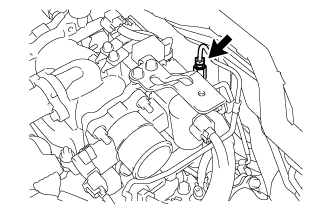 |
Temporarily install the tube connector to flexible hose tube with the 2 bolts.
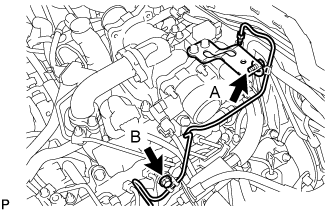 |
Tighten the bolt labeled A.
- Torque:
- 20 N*m{204 kgf*cm, 15 ft.*lbf}
- NOTICE:
- Tighten the bolt labeled B after installing the clutch hose.
| 35. INSTALL AIR TUBE SUB-ASSEMBLY LH |
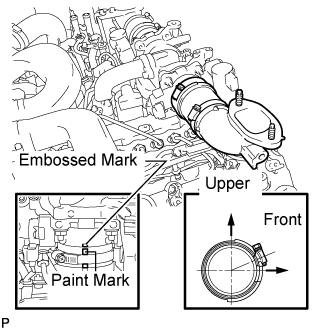 |
Install the air tube to the throttle body.
Align the embossed mark of the throttle body with the paint mark of the No. 4 air hose.
Tighten the hose clamp so that it is 7 to 11 mm (0.276 to 0.433 in.) from the end of the hose as shown in the illustration.
- Torque:
- 6.3 N*m{64 kgf*cm, 56 in.*lbf}
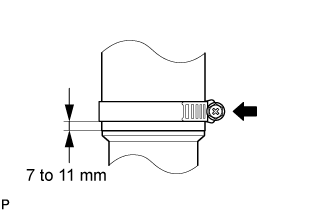 |
| 36. INSTALL CLUTCH HOSE (for Manual Transmission) |
Connect the clutch hose to the air tube with the bolt labeled A.
 |
Temporarily install the clutch hose to the clutch master cylinder tube to flexible hose tube and tube connector to flexible hose tube, and fix it in place with the 2 clips.
- Torque:
- 20 N*m{204 kgf*cm, 15 ft.*lbf}
Tighten the bolt labeled B.
- Torque:
- 20 N*m{204 kgf*cm, 15 ft.*lbf}
Tighten the flexible hose tube.
- NOTICE:
- Do not bend or damage the flexible hose tube.
- Do not allow any foreign matter such as dirt and dust to enter the flexible hose tube from the connecting points.
- HINT:
- Use a torque wrench with a fulcrum length of 30 cm (11.8 in.). If using a torque wrench with a length that is not 30 cm (11.8 in.), calculate the torque specification for the torque wrench and SST based on the "without SST" torque specification (Click here).
- Make sure union nut wrench and the wrench are connected in a straight line.
Using a 10 mm union nut wrench, tighten the 2 flare nuts of the flexible hose tube.
- Torque:
- without union nut wrench:
- 15 N*m{154 kgf*cm, 11 ft.*lbf}
- with union nut wrench:
- 14 N*m{141 kgf*cm, 10 ft.*lbf}
Using a 10 mm union nut wrench, tighten the flare nut of the flexible hose tube.
- Torque:
- without union nut wrench:
- 15 N*m{154 kgf*cm, 11 ft.*lbf}
- with union nut wrench:
- 14 N*m{141 kgf*cm, 10 ft.*lbf}


| 37. INSTALL AIR TUBE SUB-ASSEMBLY RH |
 |
Install the air tube to the throttle body.
Align the embossed mark of the throttle body with the paint mark of the No. 4 air hose.
Tighten the hose clamp so that it is 7 to 11 mm (0.276 to 0.433 in.) from the end of the hose as shown in the illustration.
- Torque:
- 6.3 N*m{64 kgf*cm, 56 in.*lbf}
 |
| 38. INSTALL NO. 2 ENGINE OIL LEVEL DIPSTICK GUIDE |
Apply a light coat of engine oil to a new O-ring.
Install the O-ring to the No. 2 engine oil level dipstick guide.
Install the No. 2 engine oil level dipstick guide with the 2 bolts.
- Torque:
- 10 N*m{102 kgf*cm, 7 ft.*lbf}
Connect the ventilation hose to the cylinder head cover RH.
Connect the wire harness clamp to the No. 2 engine oil level dipstick guide bracket.
| 39. CONNECT WATER HOSE SUB-ASSEMBLY |
| 40. INSTALL NO. 2 AIR CLEANER PIPE SUB-ASSEMBLY |
Connect the No. 2 air cleaner pipe to the No. 2 intake air connector pipe.
Connect the ventilation hose to the oil separator.
Install the pipe with the bolt.
- Torque:
- 21 N*m{214 kgf*cm, 15 ft.*lbf}
Tighten the hose clamp.
- Torque:
- 6.3 N*m{64 kgf*cm, 56 in.*lbf}
| 41. INSTALL NO. 4 AIR TUBE |
Install the No. 4 air tube with the bolt.
- Torque:
- 21 N*m{214 kgf*cm, 15 ft.*lbf}
Text in Illustration *1 Paint Mark *a Top
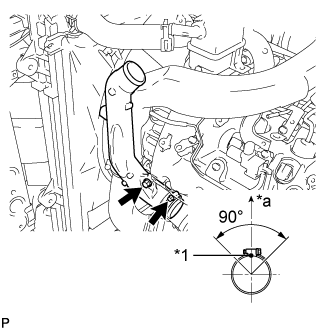 |
Tighten the hose clamp.
- Torque:
- 6.3 N*m{64 kgf*cm, 56 in.*lbf}
- HINT:
- Make sure the direction of the hose clamp is as shown in the illustration.
Install the suction hose with the bolt.
- Torque:
- 9.8 N*m{100 kgf*cm, 87 in.*lbf}
| 42. INSTALL NO. 2 AIR HOSE |
Connect the No. 2 air hose with the hose clamp.
- Torque:
- 6.3 N*m{64 kgf*cm, 56 in.*lbf}
Text in Illustration *1 Protrusion *2 Paint Mark *a Top - HINT:
- Align the paint mark of the air hose with the protrusion and push on the air hose so that distance B is 0 to 3 mm (0 to 0.118 in.).
- Position the clamp so that distance A is 2 to 6 mm (0.0787 to 0.236 in.).
- Make sure the direction of the hose clamp is as shown in the illustration.
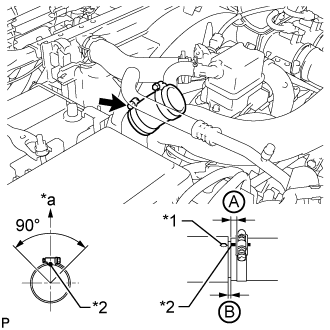 |
| 43. INSTALL NO. 1 AIR CLEANER PIPE SUB-ASSEMBLY |
Connect the No. 1 air cleaner pipe to the No. 1 intake air connector pipe.
Install the pipe with the bolt.
- Torque:
- 21 N*m{214 kgf*cm, 15 ft.*lbf}
Tighten the hose clamp.
- Torque:
- 6.3 N*m{64 kgf*cm, 56 in.*lbf}
| 44. INSTALL NO. 3 AIR TUBE |
Install the No. 3 air tube with the bolt.
- Torque:
- 21 N*m{214 kgf*cm, 15 ft.*lbf}
Text in Illustration *1 Paint Mark *a Top
 |
Tighten the hose clamp.
- Torque:
- 6.3 N*m{64 kgf*cm, 56 in.*lbf}
- HINT:
- Make sure the direction of the hose clamp is as shown in the illustration.
Install the wire harness bracket with the bolt.
Install the ground wire with the nut, and attach the wire harness clamp.
- Torque:
- 8.4 N*m{85 kgf*cm, 74 in.*lbf}
| 45. INSTALL NO. 1 AIR HOSE |
Connect the No. 1 air hose with the hose clamp.
- Torque:
- 6.3 N*m{64 kgf*cm, 56 in.*lbf}
Text in Illustration *1 Protrusion *2 Paint Mark *a Top - HINT:
- Align the paint mark of the air hose with the protrusion and push on the air hose so that distance B is 0 to 3 mm (0 to 0.118 in.).
- Position the clamp so that distance A is 2 to 6 mm (0.0787 to 0.236 in.).
- Make sure the direction of the hose clamp is as shown in the illustration.
 |
| 46. INSTALL NO. 1 IDLER PULLEY BRACKET (w/ Viscous Heater) |
Install the No. 1 idler pulley bracket with the bolt.
- Torque:
- 49 N*m{495 kgf*cm, 36 ft.*lbf}
 |
| 47. INSTALL VISCOUS HEATER ASSEMBLY WITH MAGNET CLUTCH (w/ Viscous Heater) |
 |
Install the heater assembly with the 2 bolts.
- Torque:
- 48.5 N*m{495 kgf*cm, 36 ft.*lbf}
Connect the 2 heater hoses.
Using pliers, grip the claws of the clips and slide the 2 clips.
Connect the connector and attach the clamp.
| 48. INSTALL HEATER WATER PIPE SUB-ASSEMBLY (w/ Viscous Heater) |
Connect the 4 water hose ends, and install the water pipe with the 4 bolts.
- Torque:
- 9.8 N*m{100 kgf*cm, 87 in.*lbf}
| 49. INSTALL NO. 2 COOL AIR INLET (w/o Intercooler) |
Install a new gasket to the air tube LH.
Text in Illustration *1 Protrusion *a Front *b LH Side - HINT:
- Install the gasket with the protrusion facing as shown in the illustration.
 |
Install the No. 2 cool air inlet with the 3 nuts and bolt.
- Torque:
- 21 N*m{214 kgf*cm, 15 ft.*lbf}
Connect the No. 2 air hose to the No. 2 cool air inlet.
Text in Illustration *1 Protrusion *2 Paint Mark *a Top
 |
Tighten the No. 2 air hose clamp.
- Torque:
- 6.3 N*m{64 kgf*cm, 56 in.*lbf}
- HINT:
- Align the paint mark of the air hose with the protrusion and push on the air hose so that distance B is 0 to 3 mm (0 to 0.118 in.).
- Position the clamp so that distance A is 2 to 6 mm (0.0787 to 0.236 in.).
- Make sure the direction of the hose clamp is as shown in the illustration.
| 50. INSTALL NO. 1 COOL AIR INLET (w/o Intercooler) |
Install a new gasket to the air tube RH.
Text in Illustration *1 Protrusion *a Front *b RH Side - HINT:
- Install the gasket with the protrusion facing as shown in the illustration.
 |
Install the No. 1 cool air inlet with the 3 nuts and bolt.
- Torque:
- 21 N*m{214 kgf*cm, 15 ft.*lbf}
Connect the vacuum hose, intake air temperature sensor connector and turbo pressure sensor connector.
Connect the No. 1 air hose to the No. 1 cool air inlet.
Text in Illustration *1 Protrusion *2 Paint Mark *a Top
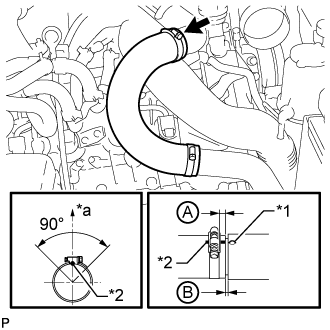 |
Tighten the No. 1 air hose clamp.
- Torque:
- 6.3 N*m{64 kgf*cm, 56 in.*lbf}
- HINT:
- Align the paint mark of the air hose with the protrusion and push on the air hose so that distance B is 0 to 3 mm (0 to 0.118 in.).
- Position the clamp so that distance A is 2 to 6 mm (0.0787 to 0.236 in.).
- Make sure the direction of the hose clamp is as shown in the illustration.
| 51. INSTALL INTERCOOLER ASSEMBLY (w/ Intercooler) |
Install a new gasket to the air tube RH.
- HINT:
- Install the gasket with the protrusion facing as shown in the illustration.
 |
Install a new gasket to the air tube LH.
- HINT:
- Install the gasket with the protrusion facing as shown in the illustration.
 |
Align the No. 1 and No. 2 air hoses and intercooler pipes and connect them, and install the intercooler with the 2 bolts and 2 nuts labeled A in the illustration.
- Torque:
- 21 N*m{214 kgf*cm, 15 ft.*lbf}
 |
Temporarily install the 4 nuts labeled B in the illustration.
Tighten the air tube LH and RH with the 4 nuts labeled B shown in the illustration.
- Torque:
- 21 N*m{214 kgf*cm, 15 ft.*lbf}
Connect the vacuum hose, intake air temperature sensor connector and turbo pressure sensor connector.
 |
Tighten the clamp of the No. 2 air hose.
- Torque:
- 6.3 N*m{64 kgf*cm, 56 in.*lbf}
- HINT:
- Align the paint mark of the air hose with the protrusion and push in the air hose so that distance B is 0 to 3 mm (0 to 0.118 in.).
- Position the clamp so that distance A is 2 to 6 mm (0.0787 to 0.236 in.).
- Make sure the direction of the hose clamp is as shown in the illustration.
 |
Tighten the clamp of the No. 1 air hose.
- Torque:
- 6.3 N*m{64 kgf*cm, 56 in.*lbf}
- HINT:
- Align the paint mark of the air hose with the protrusion and push in the air hose so that distance B is 0 to 3 mm (0 to 0.118 in.).
- Position the clamp so that distance A is 2 to 6 mm (0.0787 to 0.236 in.).
- Make sure the direction of the hose clamp is as shown in the illustration.
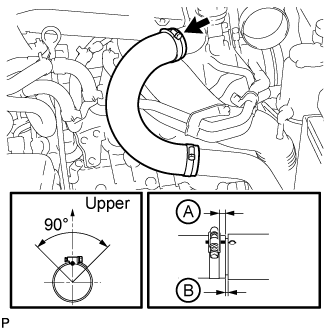 |
| 52. INSTALL FAN SHROUD WITH FAN |
Install the shroud together with the fluid coupling fan between the radiator and engine components.
- NOTICE:
- Be careful not to damage the radiator core.
Temporarily install the fluid coupling fan to the fan bracket with the 4 nuts.
- HINT:
- Tighten the nuts as much as possible by hand.
 |
Attach the shroud claws to the radiator.
 |
Install the shroud with the 2 bolts.
- Torque:
- 8.0 N*m{82 kgf*cm, 71 in.*lbf}
Tighten the 4 nuts of the fluid coupling fan.
- Torque:
- 21 N*m{214 kgf*cm, 15 ft.*lbf}
 |
| 53. INSTALL OIL COOLER TUBE (for Automatic Transmission) |
Temporarily install the oil cooler tube to the fan shroud with the bolt labeled A. Install the bolt labeled B. Then tighten the bolt labeled A to the specified torque.
- Torque:
- 5.0 N*m{51 kgf*cm, 44 in.*lbf}
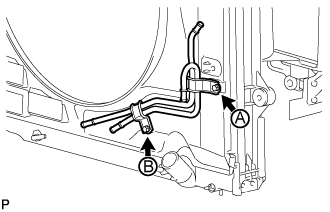 |
Connect the inlet No. 4 oil cooler hose as shown in the illustration.
Text in Illustration *1 Paint Mark - NOTICE:
- Make sure the pinching portion of each clip is facing the direction shown in the illustration.
 |
Connect the inlet No. 2 and No. 3 oil cooler hoses as shown in the illustration.
- NOTICE:
- Make sure the pinching portion of each clip is facing the direction shown in the illustration.
 |
Connect the inlet and outlet No. 1 oil cooler hoses as shown in the illustration.
Text in Illustration *1 Paint Mark - NOTICE:
- Make sure the pinching portion of each clip is facing the direction shown in the illustration.
 |
Pass the hose through the flexible hose clamp and close the clamp shown in the illustration.
| 54. INSTALL V-RIBBED BELT |
Attach a wrench to the V-ribbed belt tensioner bracket and turn the wrench clockwise.
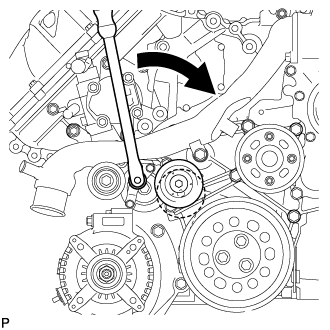 |
Install the V-ribbed belt as shown in the illustration.
 |
Check that the belt fits properly in the ribbed grooves.
- HINT:
- Check with your hand to confirm that the belt has not slipped out of the groove on the bottom of the pulley.
- If it has slipped out, replace the V-ribbed belt. Install a new V-ribbed belt.
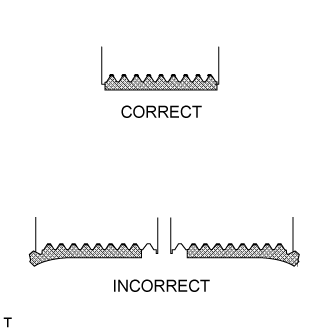 |
| 55. INSTALL NO. 3 IDLER PULLEY (w/ Viscous Heater) |
Align the No. 3 idler pulley bracket knock pin and No. 1 idler pulley bracket knock pin hole and install the No. 3 idler pulley with the nut.
- Torque:
- 88 N*m{898 kgf*cm, 64 ft.*lbf}
 |
| 56. INSTALL NO. 1 IDLER PULLEY (w/ Viscous Heater) |
Install the collar, No. 1 idler pulley and cover with the bolt.
- Torque:
- 49 N*m{495 kgf*cm, 36 ft.*lbf}
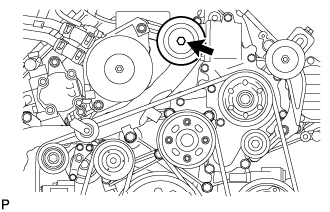 |
| 57. INSTALL V-RIBBED BELT (w/ Viscous Heater) |
Install the V-ribbed belt as shown in the illustration.
 |
Temporarily install the lock nut, and turn the bolt clockwise.
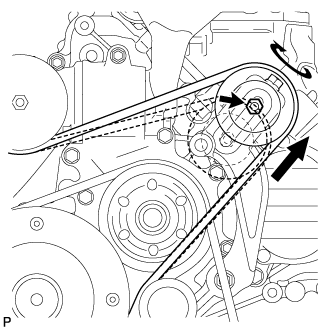 |
Using a belt tension gauge, inspect the belt tension.
- Standard Belt Tension:
Item Condition Specified Condition New belt 5 to 35°C (41 to 95°F) 550 to 800 N (56 to 82 kgf, 123.6 to 179.8 lbf) Used belt 5 to 35°C (41 to 95°F) 300 to 500 N (31 to 51 kgf, 67.4 to 112.4 lbf)
Text in Illustration *a Measuring Point - HINT:
- When measuring the tension of a new belt, measure the tension immediately after installing it to the engine but before starting the engine.
- A "new belt" is a belt which has been used for less than 5 minutes on a running engine.
- A "used belt" is a belt which has been used on a running engine for 5 minutes or more.
- After installing a new belt, run the engine for approximately 5 minutes and then recheck the tension.
 |
Tighten the nut.
- Torque:
- 40 N*m{408 kgf*cm, 30 ft.*lbf}
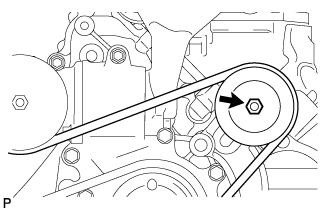 |
Check that the belt fits properly in the ribbed grooves.
- HINT:
- Check with your hand to confirm that the belt has not slipped out of the groove on the bottom of the pulley.
- If it has slipped out, replace the V-ribbed belt. Install a new V-ribbed belt.
 |
| 58. INSTALL VANE PUMP ASSEMBLY |
Apply a light coat of engine oil to a new O-ring, and install it to the vane pump.
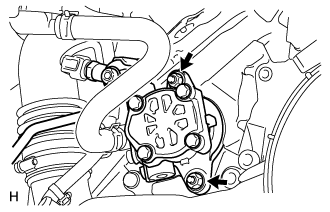 |
Install the vane pump with 2 new nuts.
- Torque:
- 29 N*m{296 kgf*cm, 21 ft.*lbf}
| 59. INSTALL RADIATOR RESERVOIR ASSEMBLY |
Install the radiator reservoir with the 3 bolts.
 |
Connect the 2 hoses to the upper radiator tank and water inlet.
- HINT:
- Make sure the directions of the hose clamps are as shown in the illustration.
| 60. INSTALL NO. 1 OIL RESERVOIR BRACKET |
Install a new bracket with the 2 bolts.
- Torque:
- 4.5 N*m{46 kgf*cm, 40 in.*lbf}
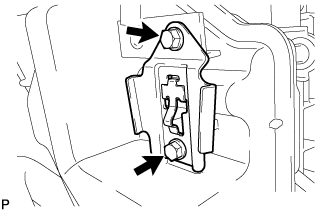 |
| 61. INSTALL VANE PUMP OIL RESERVOIR ASSEMBLY |
Install the vane pump oil reservoir to the bracket.
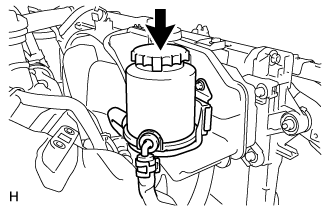 |
| 62. INSTALL INTAKE AIR CONNECTOR |
Connect the intake air connector to the No. 1 and No. 2 air cleaner pipes.
Install the connector with the 2 bolts.
- Torque:
- 21 N*m{214 kgf*cm, 15 ft.*lbf}
Tighten the 2 hose clamps.
- Torque:
- 6.3 N*m{64 kgf*cm, 56 in.*lbf}
Attach the 3 wire harness clamps.
w/o Viscous Heater:
Connect the connector to the water temperature sensor.
w/ Viscous Heater:
Connect the 2 connectors to the water temperature sensor and viscous with magnet clutch heater.
| 63. TEMPORARILY INSTALL NO. 1 AIR CLEANER HOSE |
Temporarily install the air cleaner hose to the intake air connector.
| 64. INSTALL AIR CLEANER CAP SUB-ASSEMBLY |
Connect the air cleaner cap to the air cleaner hose, and install the air cleaner cap with the 4 clamps.
Connect the mass air flow meter connector and attach the wire harness clamp to the air cleaner cap.
Attach the wire harness clamp.
Align the protrusion of the air cleaner cap and the concave portion of the air cleaner hose.
Tighten the 2 hose clamps.
- Torque:
- 2.5 N*m{25 kgf*cm, 22 in.*lbf}
| 65. INSTALL NO. 3 ENGINE ROOM WIRE |
Install the No. 3 engine room wire to the main battery and sub-battery positive terminals with the 2 nuts.
- Torque:
- 7.6 N*m{77 kgf*cm, 67 in.*lbf}
Connect the No. 3 engine room wire with the 4 clamps.

| 66. ADD ENGINE OIL |
Add fresh oil.
- Standard Engine Oil:
Item Oil Grade Oil Viscosity (SAE) w/ DPF ACEA C2
(Using engine oil other than ACEA C2 may damage catalytic converter)- 0W-30
- 5W-30
(0W-30 is best choice for fuel economy and good starting in cold weather)w/o DPF G-DLD-1, API CF-4, API CF or ACEA B1
(You may also use API CE or CD)- 5W-30
- 10W-30
- 15W-40
- 20W-50
(5W-30 is best choice for fuel economy and good starting in cold weather).
- Standard Capacity:
Item Specified Condition Drain and refill with oil filter change 9.2 liters (9.7 US qts, 8.1 Imp. qts) Drain and refill without oil filter change 8.2 liters (8.7 US qts, 7.2 Imp. qts) Dry fill 9.9 liters (10.5 US qts, 8.7 Imp. qts)
Install the oil filler cap.
| 67. BLEED AIR FROM FUEL SYSTEM |
Using the hand pump mounted on the fuel filter cap, bleed air from the fuel system. Continue pumping until the pump resistance increases.
- NOTICE:
- The maximum hand pump pumping speed is 2 strokes per second.
- The hand pump must be pushed with a full stroke during pumping.
- When the fuel pressure at the supply pump inlet port reaches a saturated pressure, the hand pump resistance increases.
- If pumping is interrupted during the air bleeding process, fuel in the fuel line may return to the fuel tank. Continue pumping until the hand pump resistance increases.
- If the hand pump resistance does not increase despite consecutively pumping 200 times or more, there may be a fuel leak between the fuel tank and fuel filter, the hand pump may be malfunctioning, or the vehicle may have run out of fuel.
- If air bleeding using the hand pump is incomplete, the common rail pressure does not rise to the pressure range necessary for normal use and the engine cannot be started.
 |
Check if the engine starts.
- NOTICE:
- Even if air bleeding using the hand pump has been completed, the starter may need to be cranked for 10 seconds or more to start the engine.
- Do not crank the engine continuously for more than 20 seconds. The battery may be discharged.
- Use a fully-charged battery.
When the engine can be started, proceed to the next step.
If the engine cannot be started, bleed air again using the hand pump until the hand pump resistance increases (refer to the procedures above). Then start the engine.
Turn the engine switch off.
Connect the intelligent tester to the DLC3.
Turn the ignition switch ON (IG) and turn the intelligent tester on.
Clear the DTCs (Click here).
Start the engine.*1
Enter the following menus: Powertrain / Engine and ECT / Active Test / Test the Fuel Leak.*2
 |
Perform the following test 5 times with on/off intervals of 10 seconds: Active Test / Test the Fuel Leak.*3
Allow the engine to idle for 3 minutes or more after performing the Active Test for the 5th time.

- HINT:
- When the Active Test "Test the Fuel Leak" is used to change the pump control mode, the actual fuel pressure inside the common rail drops below the target fuel pressure when the Active Test is off, but this is normal and does not indicate a pump malfunction.
Enter the following menus: Powertrain / Engine and ECT / DTC.
Read Current DTCs.
Clear the DTCs (Click here).
- HINT:
- It is necessary to clear the DTCs as DTC P1604 or P1605 may be stored when air is bled from the fuel system after replacing or repairing fuel system parts.
Repeat steps *1 to *3.
Enter the following menus: Powertrain / Engine and ECT / DTC.
Read Current DTCs.
- OK:
- No DTCs are output.
| 68. BLEED CLUTCH LINE |
 |
Remove the release cylinder bleeder plug cap.
Connect a vinyl tube to the bleeder plug.
Depress the clutch pedal several times, and then loosen the bleeder plug while the pedal is depressed.
When fluid no longer comes out, tighten the bleeder plug, and then release the clutch pedal.
Repeat the previous 2 steps until all the air in the fluid is completely bled.
Tighten the bleeder plug.
- Torque:
- 11 N*m{110 kgf*cm, 8 ft.*lbf}
Install the bleeder plug cap.
Check that all the air has been bled from the clutch line.
| 69. INSPECT FOR CLUTCH FLUID LEAK |
| 70. CONNECT CABLE TO NEGATIVE BATTERY TERMINAL |
- NOTICE:
- When disconnecting the cable, some systems need to be initialized after the cable is reconnected (Click here).
Connect the cables to negative (-) main battery and sub-battery battery terminals.
| 71. ADD ENGINE COOLANT |
Remove the engine air bleed cap.
 |
Connect a clear hose to the engine air bleed pipe.
 |
Using a wrench, remove the vent plug.
 |
Fill the radiator with TOYOTA SLLC to the radiator reservoir filler neck.
- HINT:
- Pour TOYOTA SLLC until it spills out of the engine air bleed pipe.
- Standard Capacity (for Automatic Transmission):
Item Specified Condition Front heater only 14.8 liters (15.6 US qts, 13.0 Imp. qts) Front heater and rear heater 17.6 liters (18.6 US qts, 15.5 Imp. qts) Front heater with viscous heater 15.2 liters (16.1 US qts, 13.4 Imp. qts) Front heater and rear heater with viscous heater 18.0 liters (19.0 US qts, 15.4 Imp. qts)
- Standard capacity (for Manual Transmission):
- 15.4 liters (16.3 US qts, 13.5 Imp. qts)
- NOTICE:
- Do not substitute plain water for engine coolant.
- HINT:
- TOYOTA vehicles are filled with TOYOTA SLLC at the factory. In order to avoid damage to the engine cooling system and other technical problems, only use TOYOTA SLLC or similar high quality ethylene glycol based non-silicate, non-amine, non-nitrite, non-borate coolant with long-life hybrid organic acid technology (coolant with long-life hybrid organic acid technology consists of a combination of low phosphates and organic acids).
 |
Install the vent plug.
- Torque:
- 2.0 N*m{20 kgf*cm, 18 in.*lbf}
- NOTICE:
- Do not tighten the plug to 5.0 N*m (51 kgf*cm, 44 in.*lbf) or more, as the plug will be damaged.
 |
Disconnect the clear hose from the engine air bleed pipe.
 |
Install the engine air bleed cap when coolant comes out.
 |
Install the radiator reservoir cap.
Start the engine.
- NOTICE:
- Immediately after starting the engine, if the radiator reservoir does not have any coolant, perform the following: 1) stop the engine, 2) wait until the coolant has cooled down, and 3) add coolant until the coolant is filled to the FULL line.
Maintain an engine speed of 3000 rpm for approximately 10 minutes so that the thermostat opens and air bleeding is performed.
- CAUTION:
When pressing the radiator hoses:- Wear protective gloves.
- Be careful as the radiator hoses are hot.
- Keep your hands away from the radiator fan
- NOTICE:
- Pay attention to the needle of the water temperature meter. Make sure that the needle does not show an abnormally high temperature.
- If there is not enough coolant, the engine may burn out or overheat.
- HINT:
- The thermostat opening timing can be confirmed by pressing the No. 2 radiator hose by hand, and checking when the engine coolant starts to flow inside the hose.
Stop the engine, and wait until the engine coolant cools down to ambient temperature.
- CAUTION:
- Do not remove the radiator reservoir cap while the engine and radiator are still hot. Pressurized, hot engine coolant and steam may be released and cause serious burns.
Check that the coolant level is between the FULL and LOW lines.
If the coolant level is above the FULL line, drain coolant so that the coolant level is between the FULL and LOW lines.
 |
| 72. INSPECT FOR FUEL LEAK |
Perform Active Test.
Connect the intelligent tester to the DLC3.
Turn the ignition switch to ON.
Start the engine.
Turn the intelligent tester ON.
Enter the following menus: Powertrain / Engine and ECT / Active Test.
Perform the Active Test.
Tester Display Test Detail Control Range Diagnostic Note Test the Fuel Leak Pressurizes fuel inside common rail and checks for fuel leaks Stop/Start - The fuel inside the common rail is pressurized to the specified value and the engine speed increases to 2000 rpm when Start is selected.
- The above conditions are preserved while Start is selected.
- The fuel inside the common rail is pressurized to the specified value and the engine speed increases to 2000 rpm when Start is selected.
| 73. INSPECT FOR OIL LEAK |
| 74. INSPECT FOR COOLANT LEAK |
- CAUTION:
- Do not remove the radiator reservoir cap while the engine and radiator are still hot. Pressurized, hot engine coolant and steam may be released and cause serious burns.
Fill the radiator with coolant and attach a radiator cap tester to the radiator reservoir.
 |
Warm up the engine.
Using the radiator cap tester, increase the pressure inside the radiator to 123 kPa (1.3 kgf/cm2, 17.8 psi), and check that the pressure does not drop.
If the pressure drops, check the hoses, radiator and water pump for leaks.
If no external leaks are found, check the cylinder block and cylinder head.
| 75. WARM UP ENGINE |
- NOTICE:
- In order to bleed air from the chain tensioner, drive the vehicle with the engine at 3000 rpm for 60 seconds or more.
| 76. INSPECT FOR EXHAUST GAS LEAK |
| 77. INSTALL NO. 1 ENGINE UNDER COVER SUB-ASSEMBLY |
Install the No. 1 engine under cover with the 10 bolts.
- Torque:
- 29 N*m{296 kgf*cm, 21 ft.*lbf}
| 78. INSTALL FRONT FENDER SPLASH SHIELD SUB-ASSEMBLY RH |
Install the front fender splash shield RH with the clip, and then install the 3 bolts and 2 screws.
| 79. INSTALL FRONT FENDER SPLASH SHIELD SUB-ASSEMBLY LH |
Install the front fender splash shield LH with the clip, and then install the 3 bolts and screw.
| 80. INSTALL FRONT FENDER APRON SEAL REAR LH |
Install the front fender apron seal rear LH with the 4 clips.
| 81. INSTALL FRONT FENDER APRON SEAL FRONT LH |
w/o KDSS:
Install the front fender apron seal front LH with the 4 clips.
w/ KDSS:
Install the front fender apron seal front LH with the 3 clips.
| 82. INSTALL FRONT FENDER APRON SEAL REAR RH |
Install the front fender apron seal rear RH with the 4 clips.
| 83. INSTALL FRONT FENDER APRON SEAL FRONT RH |
Install the front fender apron seal front RH with the 3 clips.
| 84. INSTALL FRONT WHEEL |
- Torque:
- for Aluminum Wheel:
- 131 N*m{1336 kgf*cm, 97 ft.*lbf}
- for Steel Wheel:
- 209 N*m{2131 kgf*cm, 154 ft.*lbf}
| 85. INSTALL NO. 1 ENGINE COVER SUB-ASSEMBLY (w/ Intercooler) |
Install the engine cover with the 2 nuts.
- Torque:
- 8.0 N*m{82 kgf*cm, 71 in.*lbf}
 |
| 86. INSTALL COWL TOP VENTILATOR LOUVER SUB-ASSEMBLY |
Push the ventilator louver in the direction indicated by the arrow in the illustration to attach the 17 claws and 2 clips and install the ventilator louver.
 |
| 87. INSTALL HOOD TO COWL TOP SEAL |
Attach the 12 clips and 4 clamps to install the hood to cowl top seal.
 |
Install the washer hose.
 |
| 88. INSTALL FRONT WIPER ARM RH |
Stop the wiper motor at the automatic stop position.
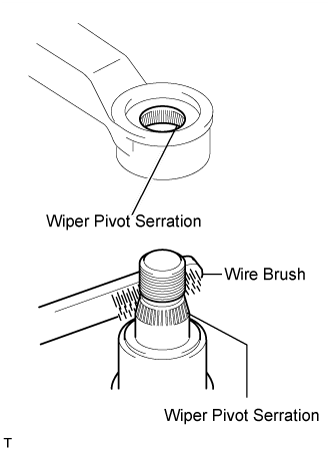 |
Clean the wiper pivot serration with a wire brush.
Install the wiper arm and blade with the nut. Make sure that the wiper arm and blade comes to the position shown in the illustration.
- Standard Measurement:
Position Specified Condition B 20.0 to 40.0 mm (0.787 to 1.57 in.)
- Torque:
- 25 N*m{255 kgf*cm, 18 ft.*lbf}
- HINT:
- Hold down the wiper arm hinge with your hand while tightening the nut.
 |
Operate the front wipers while spraying washer fluid on the windshield glass. Make sure that the front wipers function properly and there is no interference with the vehicle body.
| 89. INSTALL FRONT WIPER ARM LH |
Stop the wiper motor at the automatic stop position.
 |
Clean the wiper pivot serration with a wire brush.
Install the wiper arm and blade with the nut. Make sure that the wiper arm and blade comes to the position shown in the illustration.
- Standard Measurement:
Position Specified Condition A 16.8 to 36.8 mm (0.661 to 1.45 in.)
- Torque:
- 25 N*m{255 kgf*cm, 18 ft.*lbf}
- HINT:
- Hold down the wiper arm hinge with your hand while tightening the nut.
 |
| 90. INSTALL FRONT FENDER MAIN SEAL RH |
- HINT:
- Use the same procedure described for the LH side.
| 91. INSTALL FRONT FENDER MAIN SEAL LH |
Attach the 3 clips to install the fender main seal.
 |
| 92. INSTALL UPPER RADIATOR SUPPORT SEAL |
Install the upper radiator support seal with the 7 clips.
| 93. INSPECT ENGINE IDLE SPEED |
- NOTICE:
- Turn all the electrical systems and the A/C off.
- When checking the idle speed, move the shift lever to neutral.
- HINT:
- For more information about the GTS, refer to its operator's manual.
- If an GTS is not available, use a tachometer tester probe as a substitute.
When using the GTS:
Warm up the engine.
Connect the GTS to the DLC3.
Enter the following menus:
Powertrain / Engine / Data List / Engine Speed.- HINT:
- Refer to the GTS operator's manual for help selecting the Data List.
Inspect the engine idle speed.
- Standard Idle Speed:
Item Specified Condition for Automatic Transmission 550 to 750 rpm for Manual Transmission 500 to 600 rpm
Disconnect the GTS from the DLC3.
When not using the GTS:
Warm up and stop the engine.
Connect a tester probe of a tachometer to terminal 9 (TAC) of the DLC3 with SST.
- SST
- 09843-18040
Text in Illustration *a Front view of DLC3 Inspect the engine idle speed.
- Standard Idle Speed:
Item Specified Condition for Automatic Transmission 550 to 750 rpm for Manual Transmission 500 to 600 rpm
Disconnect the tester probe from terminal 9 (TAC) of the DLC3.

| 94. INSPECT MAXIMUM ENGINE SPEED |
Start the engine.
Fully depress the accelerator pedal.
Check the maximum engine speed.
- Maximum engine speed:
- 4700 to 4900 rpm
| 95. CHECK ENGINE OIL LEVEL |
Warm up the engine, stop the engine and wait 5 minutes. The engine oil level should be between the dipstick low level mark and full level mark.
If low, check for leakage and add oil up to the full level mark.- NOTICE:
- Do not fill engine oil above the full level mark.
- HINT:
- A certain amount of engine oil will be consumed while driving. In the following situations, oil consumption may increase, and engine oil may need to be refilled in between oil maintenance intervals.
- When the engine is new, for example directly after purchasing the vehicle or after replacing the engine.
- If low quality oil or oil of an inappropriate viscosity is used.
- When driving at high engine speed or with a heavy load, (when towing, or), when driving while accelerating or decelerating frequently.
- When leaving the idling for a long time, or when driving frequently through heavy traffic.
- When judging the amount of oil consumption, keep in mind that the oil may have become diluted, making it difficult to judge the true level accurately.
| 96. INSPECT ENGINE COOLANT LEVEL IN RESERVOIR |
 |
Check that the engine coolant level is between the LOW and FULL lines when the engine is cold.
If the engine coolant is low, check for leaks and add "TOYOTA Super Long Life Coolant (SLLC)" or similar high quality ethylene glycol based non-silicate, non-amine, non-nitrite and non-borate coolant with long-life hybrid organic acid technology to the FULL line.- NOTICE:
- Do not substitute plain water for engine coolant.